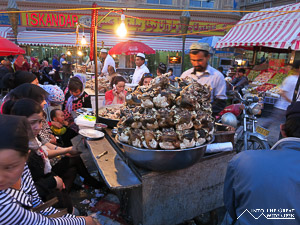Kashgar, China
The End of the Road
May 6, 2012
'Cause I know that time has numbered my days
And I'll go along with everything you say
But I'll ride home laughing, look at me now
The walls of my town, they come crumbling down
- Mumford and Sons

Kashgar is about as far removed from China as you can get and still be within the nation’s borders. The population seems to be fairly split between Han Chinese and Uighur and the city seems equally segregated. I stayed near the Old City section that is dominated by Uighurs and is near the large Id Kah Mosque and central plaza. Walking the ancient streets of the Old City it feels almost Middle Eastern and you can hear the sounds of Uighur, a Turkic language, everywhere. Sadly these unique streets are disappearing, being torn down and replaced with modern buildings, in a long line of conflicts between the central Chinese government and the local population. The latest being in late February of this year when thirteen Han Chinese were killed by seven Uighurs in an attack. Following this incident, military presence in the region has remained high.

The presence of soldiers on the streets in riot gear with plastic shields, batons, and automatic weapons is only one sign of this darker side of China that many people don’t see. It is the side of heavy handed control and repression that forces people to comply with the government’s will. Here in Xinjiang province is the first time I have come across this, experiencing how the government restricts and monitors the motions of foreigners. I was not allowed to stay at a hotel because only certain hotels are authorized to accept foreigners so that the government can keep tabs on where you are. I was not allowed to buy a bus ticket because a permit was needed to access an area. One of the two border crossings into Kyrgyzstan requires pre-arranged transport and a permit for foreigners while locals can take a bus that runs twice a week. On top of this, certain websites such as Facebook and YouTube are blocked by the government as a means to control the information that reaches the general population. All of this makes for frustrating travel experiences but at least for me it is only temporary, for those that have to live under this type of rule with fear of expressing their real opinions life must be difficult.

Despite the government’s efforts to homogenize China, Kashgar still exists in all its uniqueness. One trip to the night market reveals a collection of exciting food like sheep’s head soup, noodles with lamb and spicy sauce, fried fish, sausages filled with rice and vegetables, and steamed or fried buns stuffed with lamb and scallions. Across the street from the night market is a fabulous ice cream place that made the best walnut and almond ice cream flavors that I have ever had, rich and creamy with bits of fresh nuts liberally distributed throughout. Their fruit flavors were equally impressive with subtle tones of watermelon and melon being my favorites. The large upscale grocery store has a huge selection of freshly made Uighur desserts, Chinese copies of nearly every western candy bar, and vast aisles where you can buy everything in bulk from cooking oil to nuts to sugar wafers. The frozen poultry section is particularly interesting consisting of a freezer with assorted unpackaged frozen chicken parts, the idea being that you reach in with your bare hands and grab the pieces you want. On the street vendors sell wonderful bread fresh out of their ovens. There is the flat naan bread with spices on top and a rounder bread that looks like a bagel except the hole doesn’t go all the way through. The crust has a great crisp to it from being baked in contact with the hot metal ovens; it’s a shame they don’t have any cheese. Other than food there is the Sunday animal market were sheep, cows, and horses are bought and sold individually and in lots. On the other end of town the regular market has sprawling alleyways where everything from tape to fabric to hats are sold. But tradition only goes so far, the main plaza in front of the mosque is marred by a large jumbotron display and camels and horses are paraded out nightly for touristic appeal and photos.

This is an aspect of the city that resembles that of any other in China. Across town on the more Chinese side of the city you see modern shopping malls, traffic choked roundabouts, and a large new park overseen by the pointing arm of a giant statue of Chairman Mao. Looking at the future of the city it seems fitting that in that statue Mao’s hand is pointing away from the Old City and toward the new and modern section of Kashgar.






























































